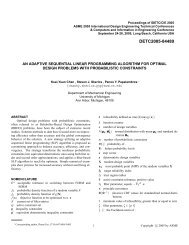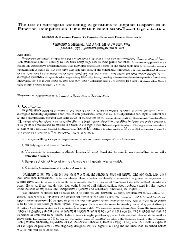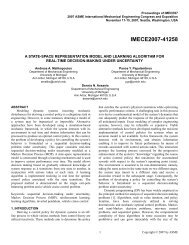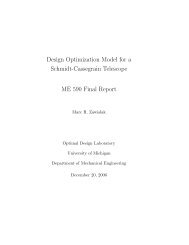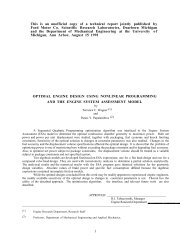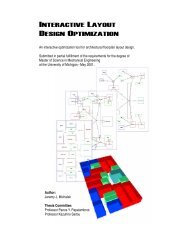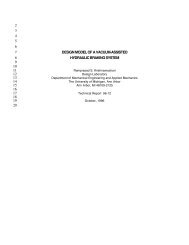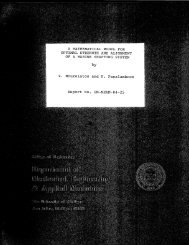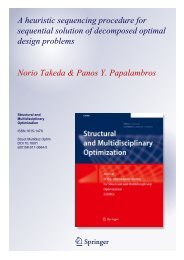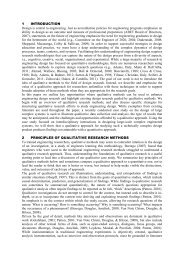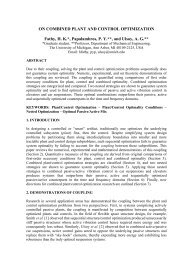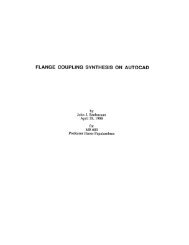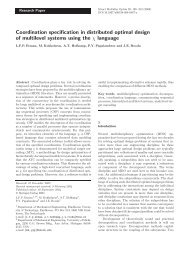Decomposition Analysis of an Automotive Powertrain Design ...
Decomposition Analysis of an Automotive Powertrain Design ...
Decomposition Analysis of an Automotive Powertrain Design ...
Create successful ePaper yourself
Turn your PDF publications into a flip-book with our unique Google optimized e-Paper software.
The U.S. metro-highway fuel economy, expressed in units <strong>of</strong> miles per gallon, represents<br />
a weighted average <strong>of</strong> the fuel consumed over the city <strong>an</strong>d highway driving cycles. In the U.S.<br />
Emissions Federal Test Procedure No. 75, oxides <strong>of</strong> nitrogen (NOx), carbon monoxide (CO),<br />
<strong>an</strong>d hydrocarbons (HC) emissions are collected <strong>an</strong>d 'bagged' over a three phase driving cycle.<br />
St<strong>an</strong>dards set by the Cle<strong>an</strong> Air Act (CAA) <strong>an</strong>d the California Air Resources Board (CARB) dictate<br />
acceptable levels (i.e., set the constraint values). Bosch (1986) provides a good description <strong>of</strong><br />
legislated driving cycles <strong>an</strong>d test procedures worldwide. Only the emissions NO <strong>an</strong>d NO 2 ,<br />
collectively referred to as NOx, are considered here.<br />
Hydrocarbons are ignored since<br />
approximately 80% <strong>of</strong> the total hydrocarbon emissions are emitted during the first 120 seconds <strong>of</strong><br />
the cycle as the catalyst warms up to maximum efficiency; they are m<strong>an</strong>aged with control strategies<br />
for cold tr<strong>an</strong>sient behavior which is beyond the scope <strong>of</strong> the problem formulated here. Similarly,<br />
catalyst efficiencies for CO are sufficient to the extent that CO emissions would rarely become <strong>an</strong><br />
active design constraint.<br />
Vehicle Relationships<br />
Appendix A has the complete nomenclature used to describe the vehicle dynamics <strong>an</strong>d<br />
Figure 4 shows a free body diagram for the vehicle. The driving equation for all the criteria is<br />
simply the bal<strong>an</strong>ce <strong>of</strong> forces on the vehicle,<br />
M dV/dt = F d - F roll - F grade - F aero . (1)<br />
The vehicle acceleration is proportional to the driving force at the road-wheel interface <strong>an</strong>d the<br />
resistive forces <strong>of</strong> rolling friction, gravity, <strong>an</strong>d air drag. The rolling resist<strong>an</strong>ce is the sum <strong>of</strong> tire<br />
friction <strong>an</strong>d brake drag on the wheels; tire friction is the product <strong>of</strong> the coefficient <strong>of</strong> rolling<br />
resist<strong>an</strong>ce <strong>an</strong>d the normal force at the wheels; brake drag is measured or modeled <strong>an</strong>d for<br />
decomposition <strong>an</strong>alysis is given as function <strong>of</strong> wheel speed,<br />
F roll = C roll F nnd + C roll F nd + (T bd (N d ) + T bnd (V/r e ))/r e (2)<br />
The rolling coefficient, C roll , is <strong>of</strong>ten determined experimentally by using the test procedure<br />
SAEJ1269 or c<strong>an</strong> be represented <strong>an</strong>alytically with <strong>an</strong> expression like (Gillespie 1992)



